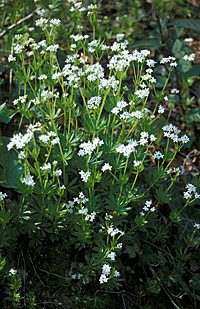Forest
Habitat types in forests according to the Habitats Directive:
 " typeof=
During your first strolls in spring you find white carpets of the wood anemone in the “Asperulo-Fagetum beech forests" (Code 9130). The eponymous woodruff flowers from April to beginning of May with tender small white flowers, and it is known for its medicinal benefits. The only occurrence in the area is west of Winterdorf in the Nature Reserve “Rastätter Ried”. Here you have to look for the so-called “biotope trees” left over by the forester for woodpeckers, beetles and other wood-dwelling species. Further information
" typeof=
During your first strolls in spring you find white carpets of the wood anemone in the “Asperulo-Fagetum beech forests" (Code 9130). The eponymous woodruff flowers from April to beginning of May with tender small white flowers, and it is known for its medicinal benefits. The only occurrence in the area is west of Winterdorf in the Nature Reserve “Rastätter Ried”. Here you have to look for the so-called “biotope trees” left over by the forester for woodpeckers, beetles and other wood-dwelling species. Further information
- " typeof= If you walk into the moist “Oak-hornbeam forests” (Code 9160) in spring or summer, you can smell it immediately: wild garlic. In the area you find the forest type in the swamp forest south of Elchesheim-Illingen und south of Ötigheim. You can pay attention to the old knotted oaks and distinguish the leaves of the different tree species: here you find ashes, oaks, hornbeam and different species of maple and elm. Further information
- " typeof= Forest sites which are frequently flooded are covered by soft wood alluvial forests (Alluvial forests with Alnus glutinosa and Fraxinus excelsior, Code 91E0). Willows and alders are adapted best to floods. Typical is the While Willow with its finely haired leaves shining silver in the sunlight. Doubtlessly you will find some impressive and very old willow trees. Forestry has promoted stands of white willow on several sites over the last years, e.g. near Ottersdorf and close to Elchesheim-Illingen. The intended measures to re-wet the river valley will be beneficial for the softwood forests. Further information
- The ”Riparian mixed forests of Quercus robur, Ulmus and Fraxinus" (Code 91F0) are flooded less frequently. In the area they stock for example in the open floodplain north of Iffezheim. In spring you find here the blue stands of glory of the snow or you can hear bumblebees tumbling between the artful flowers of columbines. Please don’t gather this flowerage but enjoy its sight, and perhaps you can take some good photographs. Further information



